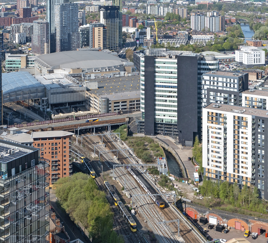“The value for money arguments around rail need to be addressed, to allow more people to access it. It is that simple. We reached ‘peak price’ on rail a long time ago. What has broken is rail’s ability to pass on its own inefficiencies through price rises. That has gone. If you put up prices any further, it will put many people off and entrench the perception that only people with money can get on the train.”
FEWER TRAINS, FEWER BUSES
In November 2021 (before the Omicron wave), rail was averaging 71% of pre-pandemic weekday patronage. Bus use was running at 81%. Car use has currently settled at 85%.
The Less is More study breaks down that pattern. For both bus and train travel, the reductions in usage were greatest among females, older people, the most highly educated, higher social grades, and those with children and cars.
Although the reductions in train travel are greater than on the buses, those on rail have been concentrated among a narrower subset of passengers: females and those with the lowest and highest education.
The study points out that this provides an opportunity to target specific segments of the population in campaigns, to attract people back.
But not the more general half-price off-peak campaign outside school holidays launched after Easter by Secretary of State for Transport Grant Shapps.
The report warns: “There is likely to be less commuting and much more variable patterns of commuting, all of which needs proactively managing. Lower public transport use can also bring about bad outcomes where service withdrawals make the service less attractive to the remaining users, who then look for other options.”
“There are two hits to the traditional rail market: city centre commuting to offices and city centre retail, both partly replaced by doing it from home,” says Stephen Joseph, formerly head of the Campaign for Better Transport and now a transport policy consultant and visiting Professor at the University of Hertfordshire.
“I just don’t think rail passenger numbers will come back fully, and the study is the first time we have reliable numbers to support this. Paradoxically, there will be more demand for late-night trains, because more leisure travellers will want to come home after an evening out.”
Professor Docherty says: “It shows the fragility of why we have been spending all this money on rail. It was being justified by the belief that magical agglomeration impacts occur - cramming more people into city centres, particularly London. It was used to justify lots more spending on increasing peak capacity.
“That concept is in some difficulty, given what we now know about people’s productivity working from home and using digital tools.
“But when you cut services, you make the overall product less attractive. Once you lose passengers, it is really hard to get them back. There’s a constituency of what used to be very regular commuters who are now just occasional commuters, who could shift to road. If they only go to the office once or twice a week, are they really going to go by train?”
Great Western Railway Managing Director Mark Hopwood counters: “I wouldn’t share that analysis, at least on our services. We have seen some important signs of growth. I wouldn’t pretend it’s a full recovery. But I had to drive my car further along the car park at Didcot to find a space this morning than I have done since the start of the pandemic.
“Coming in, I struggled to get a seat in First Class. A First World problem, I realise, but nonetheless an indication that things are getting better. Someone else on the 0656 from Chippenham told me the First Class was absolutely full.
“We have one or two commuter trains into Paddington that we reduced to eight cars, and which we are now looking to return to 12 cars.
“The shop workers, warehouse staff, security guards and so on, who have to travel to work, they continue to do so. We have seen growth in college students and school kids. In some places that is a significant amount of business for us.
“We are also seeing the return of non-commuting business travel, things such as seminars and conferences. Each week there is a small amount of growth towards where we were.
“That said, I was talking to a management accountant at the weekend. His business has moved out of London and is now giving people the option of working in regional offices, and only expecting them in once a week. And his partner also works only one day a week in the office.
“When people do go in, they are not necessarily at the desk for 0900, so the concept of using off-peak products for commuting continues.”
Hopwood says the change should not be seen as entirely bad news for the railway. He now has very little rolling stock that only emerges from the depot to serve the morning and evening peaks. GWR has strong off-peak demand, so the same trains are used all day on much the same timetable.
“In railway economics, if we end up with a smoother transition between the peak and off-peak, with fewer resources tied up for only a couple of turns in the day, then that is beneficial.”














